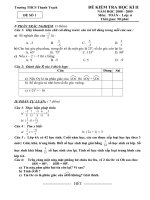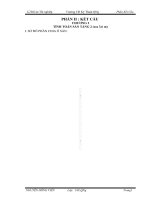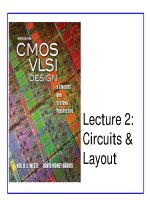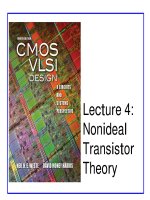CMOS VLSI Design - Lecture 6: Power potx
Bạn đang xem bản rút gọn của tài liệu. Xem và tải ngay bản đầy đủ của tài liệu tại đây (267.54 KB, 29 trang )
Lecture 6:
Power
CMOS VLSI DesignCMOS VLSI Design
4th Ed.
7: Power 2
Outline
Power and Energy
Dynamic Power
Static Power
CMOS VLSI DesignCMOS VLSI Design
4th Ed.
7: Power 3
Power and Energy
Power is drawn from a voltage source attached to
the V
DD
pin(s) of a chip.
Instantaneous Power:
Energy:
Average Power:
() () ()Pt ItVt=
0
()
T
E P t dt=
∫
avg
0
1
()
T
E
P P t dt
TT
= =
∫
CMOS VLSI DesignCMOS VLSI Design
4th Ed.
7: Power 4
Power in Circuit Elements
( ) ( )
VDD DD DD
P t I tV=
( )
( )
( )
2
2
R
RR
Vt
P t I tR
R
= =
( ) ( ) ( )
( )
00
2
1
2
0
C
C
V
C
dV
E I t V t dt C V t dt
dt
C V t dV CV
∞∞
= =
= =
∫∫
∫
CMOS VLSI DesignCMOS VLSI Design
4th Ed.
7: Power 5
Charging a Capacitor
When the gate output rises
–
Energy stored in capacitor is
– But energy drawn from the supply is
– Half the energy from V
DD
is dissipated in the pMOS
transistor as heat, other half stored in capacitor
When the gate output falls
– Energy in capacitor is dumped to GND
– Dissipated as heat in the nMOS transistor
2
1
2
C L DD
E CV=
( )
00
2
0
DD
VDD DD L DD
V
L DD L DD
dV
E I t V dt C V dt
dt
CV dV CV
∞∞
= =
= =
∫∫
∫
CMOS VLSI DesignCMOS VLSI Design
4th Ed.
7: Power 6
Switching Waveforms
Example: V
DD
= 1.0 V, C
L
= 150 fF, f = 1 GHz
CMOS VLSI DesignCMOS VLSI Design
4th Ed.
7: Power 7
Switching Power
[ ]
switching
0
0
sw
2
sw
1
()
()
T
DD DD
T
DD
DD
DD
DD
DD
P i t V dt
T
V
i t dt
T
V
Tf CV
T
CV f
=
=
=
=
∫
∫
C
f
sw
i
DD
(t)
VDD
CMOS VLSI DesignCMOS VLSI Design
4th Ed.
7: Power 8
Activity Factor
Suppose the system clock frequency = f
Let f
sw
= αf, where α = activity factor
– If the signal is a clock, α = 1
– If the signal switches once per cycle, α = ½
Dynamic power:
2
switching DD
P CV f
α
=
CMOS VLSI DesignCMOS VLSI Design
4th Ed.
7: Power 9
Short Circuit Current
When transistors switch, both nMOS and pMOS
networks may be momentarily ON at once
Leads to a blip of “short circuit” current.
< 10% of dynamic power if rise/fall times are
comparable for input and output
We will generally ignore this component
CMOS VLSI DesignCMOS VLSI Design
4th Ed.
7: Power 10
Power Dissipation Sources
P
total
= P
dynamic
+ P
static
Dynamic power: P
dynamic
= P
switching
+ P
shortcircuit
– Switching load capacitances
– Short-circuit current
Static power: P
static
= (I
sub
+ I
gate
+ I
junct
+ I
contention
)V
DD
– Subthreshold leakage
– Gate leakage
– Junction leakage
– Contention current
CMOS VLSI DesignCMOS VLSI Design
4th Ed.
7: Power 11
Dynamic Power Example
1 billion transistor chip
– 50M logic transistors
• Average width: 12 λ
• Activity factor = 0.1
– 950M memory transistors
• Average width: 4 λ
• Activity factor = 0.02
– 1.0 V 65 nm process
– C = 1 fF/µm (gate) + 0.8 fF/µm (diffusion)
Estimate dynamic power consumption @ 1 GHz.
Neglect wire capacitance and short-circuit current.
CMOS VLSI DesignCMOS VLSI Design
4th Ed.
7: Power 12
Solution
( )
( )( )( )
(
)
( )( )( )
( ) ( )
6
logic
6
mem
2
dynamic logic mem
50 10 12 0.025 / 1.8 / 27 nF
950 10 4 0.025 / 1.8 / 171 nF
0.1 0.02 1.0 1.0 GHz 6.1 W
C m fF m
C m fF m
P CC
λ µλ µ
λ µλ µ
=×=
=×=
=+=
CMOS VLSI DesignCMOS VLSI Design
4th Ed.
7: Power 13
Dynamic Power Reduction
Try to minimize:
– Activity factor
– Capacitance
– Supply voltage
– Frequency
2
switching DD
P CV f
α
=
CMOS VLSI DesignCMOS VLSI Design
4th Ed.
7: Power 14
Activity Factor Estimation
Let P
i
= Prob(node i = 1)
– P
i
= 1-P
i
α
i
= P
i
* P
i
Completely random data has P = 0.5 and α = 0.25
Data is often not completely random
– e.g. upper bits of 64-bit words representing bank
account balances are usually 0
Data propagating through ANDs and ORs has lower
activity factor
– Depends on design, but typically α ≈ 0.1
CMOS VLSI DesignCMOS VLSI Design
4th Ed.
7: Power 15
Switching Probability
CMOS VLSI DesignCMOS VLSI Design
4th Ed.
7: Power 16
Example
A 4-input AND is built out of two levels of gates
Estimate the activity factor at each node if the inputs
have P = 0.5
CMOS VLSI DesignCMOS VLSI Design
4th Ed.
7: Power 17
Clock Gating
The best way to reduce the activity is to turn off the
clock to registers in unused blocks
– Saves clock activity (α = 1)
– Eliminates all switching activity in the block
– Requires determining if block will be used
CMOS VLSI DesignCMOS VLSI Design
4th Ed.
7: Power 18
Capacitance
Gate capacitance
– Fewer stages of logic
– Small gate sizes
Wire capacitance
– Good floorplanning to keep communicating
blocks close to each other
– Drive long wires with inverters or buffers rather
than complex gates
CMOS VLSI DesignCMOS VLSI Design
4th Ed.
7: Power 19
Voltage / Frequency
Run each block at the lowest possible voltage and
frequency that meets performance requirements
Voltage Domains
– Provide separate supplies to different blocks
– Level converters required when crossing
from low to high V
DD
domains
Dynamic Voltage Scaling
– Adjust V
DD
and f according to
workload
CMOS VLSI DesignCMOS VLSI Design
4th Ed.
7: Power 20
Static Power
Static power is consumed even when chip is
quiescent.
– Leakage draws power from nominally OFF
devices
– Ratioed circuits burn power in fight between ON
transistors
CMOS VLSI DesignCMOS VLSI Design
4th Ed.
7: Power 21
Static Power Example
Revisit power estimation for 1 billion transistor chip
Estimate static power consumption
– Subthreshold leakage
• Normal V
t
: 100 nA/µm
• High V
t
: 10 nA/µm
• High Vt used in all memories and in 95% of
logic gates
– Gate leakage 5 nA/µm
– Junction leakage negligible
CMOS VLSI DesignCMOS VLSI Design
4th Ed.
7: Power 22
Solution
( )
( )( )( )
( )
( )( )
( )
( ) ( )
( )
t
t
tt
tt
66
normal-V
66 6
high-V
normal-V high-V
normal-V high-V
50 10 12 0.025 m / 0.05 0.75 10 m
50 10 12 0.95 950 10 4 0.025 m / 109.25 10 m
100 nA/ m+ 10 nA/ m / 2 584 mA
5 nA/ m / 2
sub
gate
W
W
IW W
IW W
λ µλ µ
λ λ µλ µ
µµ
µ
=×=×
=× +× = ×
=× ×=
= +× =
( )( )
275 mA
P 584 mA 275 mA 1.0 V 859 mW
static
=+=
CMOS VLSI DesignCMOS VLSI Design
4th Ed.
7: Power 23
Subthreshold Leakage
For V
ds
> 50 mV
I
off
= leakage at V
gs
= 0, V
ds
= V
DD
( )
10
gs ds DD sb
V V V kV
S
sub off
II
γ
η
+ −−
≈
Typical values in 65 nm
I
off
= 100 nA/µm @ V
t
= 0.3 V
I
off
= 10 nA/µm @ V
t
= 0.4 V
I
off
= 1 nA/µm @ V
t
= 0.5 V
η = 0.1
k
γ
= 0.1
S = 100 mV/decade
CMOS VLSI DesignCMOS VLSI Design
4th Ed.
7: Power 24
Stack Effect
Series OFF transistors have less leakage
– V
x
> 0, so N2 has negative V
gs
– Leakage through 2-stack reduces ~10x
– Leakage through 3-stack reduces further
( )
( )
( )
21
10 10
x DD x DD x
x DD
V V V V kV
VV
SS
sub off off
NN
II I
γ
η
η
−+ − − −
−
= =
12
DD
x
V
V
k
γ
η
η
=
++
1
12
10 10
DD
DD
k
V
k
V
SS
sub off off
II I
γ
γ
η
η
η
η
++
−
++
−
= ≈
CMOS VLSI DesignCMOS VLSI Design
4th Ed.
7: Power 25
Leakage Control
Leakage and delay trade off
– Aim for low leakage in sleep and low delay in
active mode
To reduce leakage:
– Increase V
t
: multiple V
t
• Use low V
t
only in critical circuits
– Increase V
s
: stack effect
• Input vector control in sleep
– Decrease V
b
• Reverse body bias in sleep
• Or forward body bias in active mode









